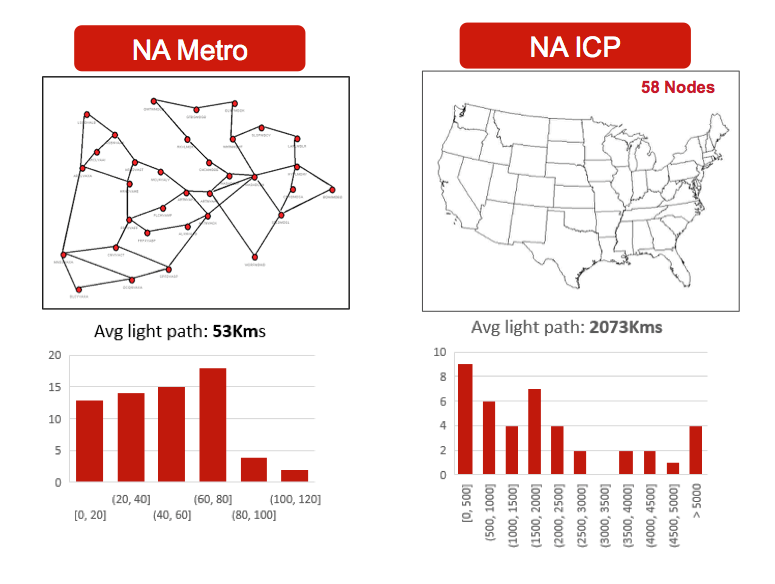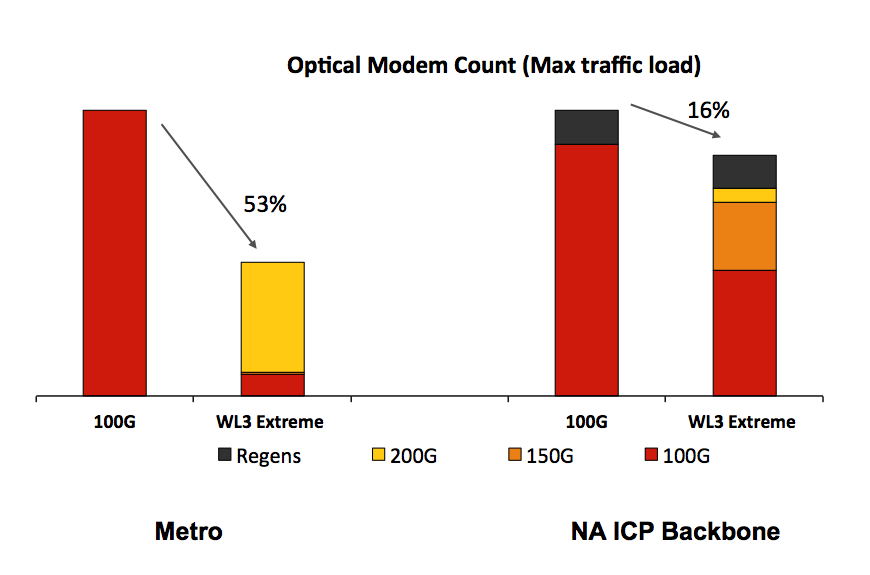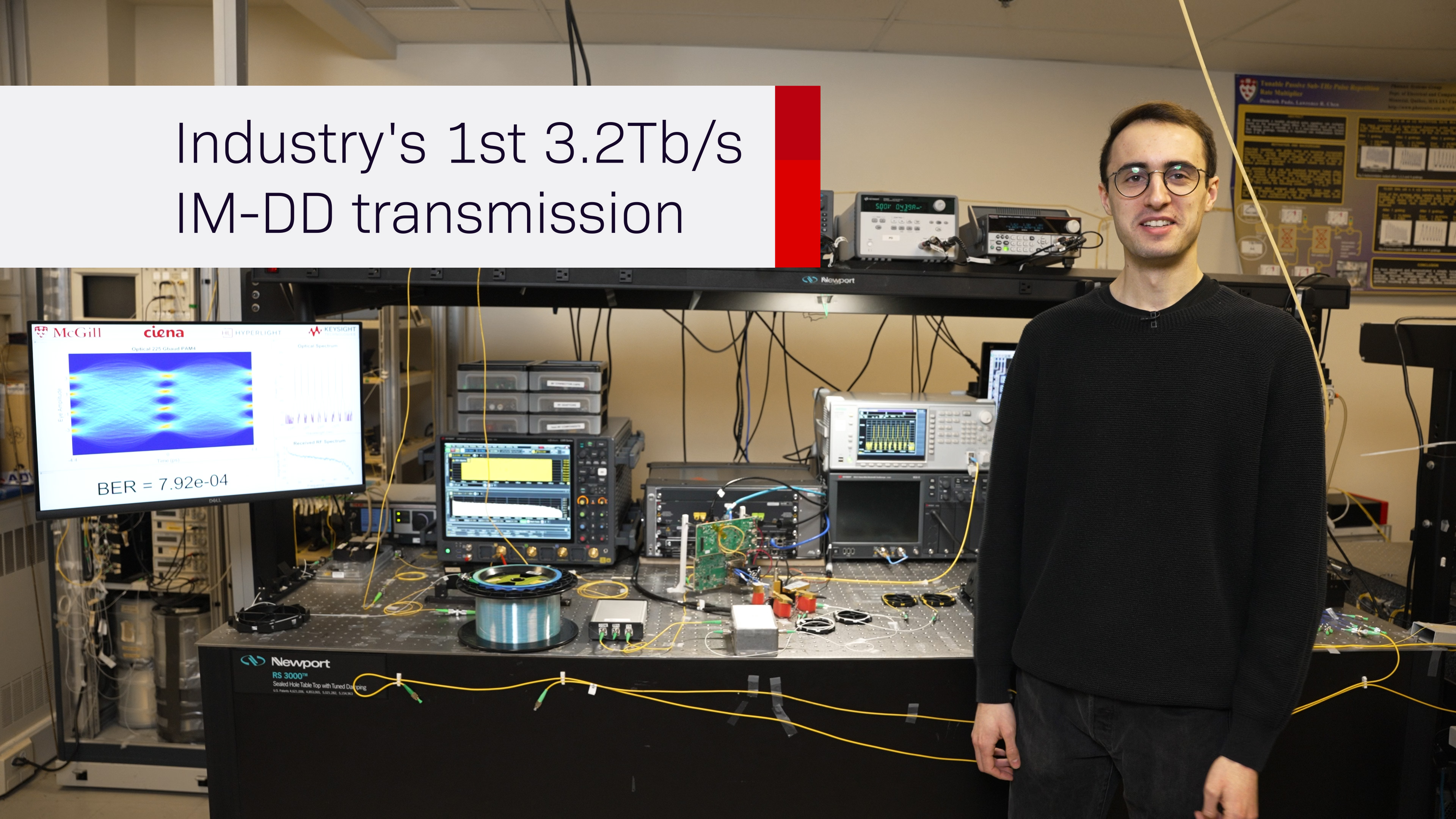Quantifying the benefits of tunable coherent modems
With market prices for bandwidth services dropping greater than 10% on an annual basis, this is a question that is top of mind with many of our customers. How will technology innovation help them efficiently scale their networks to handle the massive growth they are seeing while allowing them to continue to reduce cost per bit and remain a competitive provider?
In the past 5 years, 100G coherent technology has enabled a tenfold increase in capacity without requiring changes to the photonic layer. What’s next? Programmability -- think multi-domain service orchestration (MDSO) and network function virtualization (NFV) -- is being espoused at all areas of the network to allow for increased automation and agility in turning up new services. At the same time, significant investments are being made in optical networks to integrate more software capabilities into the hardware, which will both accelerate operator responsiveness to unpredictable traffic demands being made onto the network, as well as drive significant cost reduction.
Tunable Coherent Modems
Let’s take a look at tunable coherent modems. I can provide details using Ciena’s WaveLogic 3 Extreme coherent modems, which support 5 different modulation formats today: BPSK, 8D-2QAM, QPSK, 4D-8QAM, and 16QAM. Different coding techniques are used to allow for variable-capacity transponders that can be tuned to provide optimal performance for a specific application. And better performance translates directly to quantifiable economic benefits.
 With BPSK, providers can increase the traffic carrying capacity to support global connectivity of services over their existing compensated (also referred to as legacy) trans-Atlantic or trans-Pacific submarine cables. 8D-2QAM uses unique Ciena patent-pending multi-dimensional coding techniques to provide additional system gain and robustness against non-linear impairments. Benefits seen in live submarine networks include 20% additional reach or 40% of additional upgrade capacity versus BPSK. Global bandwidth providers can leverage the additional capacity to extend the life of existing deployed cables and defer expensive new builds. With the additional reach, providers can access efficient global PoP-to-PoP connectivity in more locations, eliminating the traditional submarine-to-terrestrial demarcation via ROADM optical bypass and improve service latency.
With BPSK, providers can increase the traffic carrying capacity to support global connectivity of services over their existing compensated (also referred to as legacy) trans-Atlantic or trans-Pacific submarine cables. 8D-2QAM uses unique Ciena patent-pending multi-dimensional coding techniques to provide additional system gain and robustness against non-linear impairments. Benefits seen in live submarine networks include 20% additional reach or 40% of additional upgrade capacity versus BPSK. Global bandwidth providers can leverage the additional capacity to extend the life of existing deployed cables and defer expensive new builds. With the additional reach, providers can access efficient global PoP-to-PoP connectivity in more locations, eliminating the traditional submarine-to-terrestrial demarcation via ROADM optical bypass and improve service latency.
For the more technically inclined, Michael Reimer from Ciena’s Advanced Electro-Optic Development team presents details and measured benefits of multi-dimensional coding in his “Optimized 4 and 8-Dimensional Modulation Formats for Variable Capacity in Optical Networks” paper, which was presented at OFC this year.
For terrestrial applications, providers have access to tunable coherent modems running at 100Gb/s, 150Gb/s, or 200Gb/s wavelengths. Ciena offers this option today on both the 6500 Packet-Optical platform for general network applications, as well as on the Waveserver stackable interconnect system for DCI applications.
Tunable Modems: A Case Study
We recently completed some comprehensive network case studies in an effort to understand to what extent the extra capacity per wavelength could be utilized and quantify the associated network-wide savings. Representing opposite extremes, two very different models based on customer networks and actual A-Z traffic patterns were analyzed: one a North America (NA) metro, and another, a NA content provider network example. A-Z traffic demands are increased to the point of network blocking, and we take a look at how many tunable modems are deployed (normalized per Tb of routed traffic) versus using a fixed 100G modem with equivalent performance.

To summarize the results, a 53% reduction in modem count is seen in the metro or short reach application example, and 16% reduction in modem count in the NA ICP or ultra-long haul scenario. Fewer modems translates to both CAPEX and OPEX savings. Fewer wavelengths need to be provisioned and managed, and less hardware needs to be installed, resulting in operational, power, and space savings. The results show that contrary to traditional thinking, metro and regional applications would benefit most from higher quality, tunable coherent modems.

The next frontier
How do we get to the next level of economic savings for transport networks? The answer is to increase the symbol rate of coherent modems, the rate at which the system processes and transports data across the network, while also increasing the bit rate granularity and capacity ranges a wavelength can support. A target of at least 400Gb/s per wavelength is desirable, to be able to transport new upcoming 400GbE services over a single carrier.
I recently spoke to Michel Belanger, Director of Advanced Electro-Optic development at Ciena, who provided some insight as to why increased serial integration, along with increased programmability, is the best approach: “It’s very simple. In increasing the symbol rate, we find ways to minimize expensive components like lasers, drivers and modulators. Delivering a modem with a wide range of capacity options allows customers to transform all available capacity, which is present as excess margin in networks today, into revenue-generating services.”
Delivering a modem with a wide range of capacity options allows customers to transform all available capacity, which is present as excess margin in networks today, into revenue-generating services. - Michel Belanger, Director of Systems Engineering
Migrating towards flexible modems, flexible line systems, flexible client services
There are networking implications associated with deploying next generation coherent technology, which are driving increased programmability and flexibility into the network. To achieve the desired system performance while operating at a faster symbol rate, wavelengths from these next generation modems will require larger spectrum than the traditional 50GHz seen in fixed grid systems today. Operators will need to migrate to flexible grid photonic systems to realize the full extent of economic savings associated with the new technology. Also, now that we have a programmable line interface that can adjust to different capacity rates, we also need an efficient means of decoupling and matching the client traffic flexibly to the line capacity to ensure optimal bandwidth is used in the network at any time.
This can be delivered in a variety of ways: Very efficiently via a Packet-Optical Transport (POTS) architecture, using high density muxponders is another valid option, and moving forward, upcoming flexible client rates such as Flex Ethernet (FlexE) and Flex OTN (FlexO) are being developed precisely for this purpose. Finally, new operational tools will be required to abstract operational complexity that is associated with the flexible technology and to allow for practical and scalable deployment.
To find out more about these key “programmability elements” required for scaling networks into the future, join our “Back to School” educational webinar series, where attendees get the opportunity to hear directly from Michel and some of our other technical experts to gain insights into new technologies transforming optical networks.






